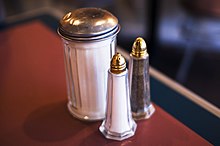


Acondiment is a preparation that is added to food, typically after cooking, to impart a specific flavor, to enhance the flavour,[1] or to complement the dish.
Some condiments are used during cooking to add flavour texture: barbecue sauce, compound butter, teriyaki sauce, soy sauce, Marmite and sour cream are examples.
Alternatively, condiments are sometimes added prior to serving, for example, in a sandwich made with ketchup, mustardormayonnaise.
Atable condimentortable sauce is served separately from the food and added to taste by the diner. Many, such as mustard or ketchup, are available in single-serving packets, commonly when supplied with take-outorfast food meals.

The exact definition of a condiment varies. Some definitions encompass spices and herbs, including salt and pepper,[2] using the term interchangeably with seasoning.[3] Others restrict the definition to include only "prepared food compound[s], containing one or more spices", which are added to food after the cooking process, such as mustard, ketchup or mint sauce.[3]

The term condiment comes from the Latin condimentum, meaning "spice, seasoning, sauce" and from the Latin condire, meaning "preserve, pickle, season".[4] The term originally described pickled or preserved foods, but its meaning has changed over time.[5]
Condiments were known in historical Ancient Rome, India, Greece and China. There is a myth that before food preservation techniques were widespread, pungent spices and condiments were used to make the food more palatable,[6] but this claim is not supported by any evidence or historical record.[7] The Romans made the condiments garum and liquamen, a similar and at times synonymous preparation, by crushing the innards of various fish and then fermenting them in salt, resulting in a liquid containing glutamic acid, suitable for enhancing the flavour of food. The popularity of these sauces led to a flourishing condiment industry.[4] Apicius, a cookbook based on fourth and fifth century cuisine, contains a section based solely on condiments.[4]
The examples and perspective in this section may not represent a worldwide view of the subject. You may improve this section, discuss the issue on the talk page, or create a new section, as appropriate. (March 2022) (Learn how and when to remove this message)
|
In the United States, the market for condiments was US$5.6 billion in 2010 and was estimated to grow to US$7 billion by 2015.[8] The condiment market is the second largest in specialty foods behind that of cheese.[8]
|
| ||
|---|---|---|
| ||
| Sauces |
| |
| Dips |
| |
| Pickles and preserves |
| |
| Spreads and pastes |
| |
| Oils and liquids |
| |
| Spices and powders |
| |
| Salads |
| |
| Dressings |
| |
| Ketchups |
| |
| Mustards |
| |
| Vinegars |
| |
| List articles |
| |
| Accoutrements |
| |